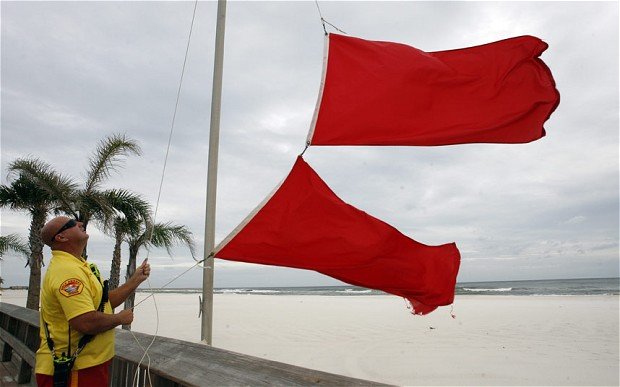Tropical Storm Isaac bearing down on the Gulf Coast and New Orleans is now a hurricane, US forecasters say.
Hurricane Isaac boasting winds of at least 75 mph (120 km/h), is likely to make landfall by Tuesday night.
The storm is expected to hit New Orleans seven years after the much stronger Hurricane Katrina.
US President Barack Obama has warned residents in the path of the storm they should not “tempt fate” and should heed evacuation warnings.
In an update at 13:00 CDT the National Hurricane Center said the storm was 135 miles (220 km) south-east of New Orleans, moving north-west at 10 mph (17 km/h).
Barack Obama has declared an emergency in Louisiana, allowing federal funds to be released to local authorities.
“As we prepare for Isaac to hit, I want to encourage all residents of the Gulf Coast to listen to your local officials and follow their directions – including if they tell you to evacuate,” Barack Obama said on Tuesday.
Speaking from the White House, he added: “Now is not the time to tempt fate. Now is not the time to dismiss official warnings. You need to take this seriously.”

Shortly after Isaac reached hurricane status, Louisiana Governor Bobby Jindal called for the Federal Emergency Management Agency (FEMA) to make a full emergency declaration for the state.
He told reporters that a declaration made on Monday did not allow for the reimbursement for state’s expenses from the storm.
“We have learned from past experiences that you cannot wait and you have to push the federal bureaucracy,” Bobby Jindal, who cancelled an appearance at the Republican National Convention because of the storm, said.
New Orleans Mayor Mitch Landrieu said his city was “officially in the fight” on Tuesday, as he confirmed its airport was closed and would not serve as a shelter.
Mitch Landrieu said that a 26 ft (8 m) high levee gate that now protects the areas of the city that were badly flooded in 2005 – which he dubbed “the great wall of New Orleans” – was closed on Tuesday morning.
“We will not have a Katrina-like event,” he said, adding there will still be parts of the city that will likely be flooded.
“Do not let this storm lull you into complacency,” he said.
“People may be getting bored. It’s better to be bored than to get hurt.”
Officials have not ordered any evacuations, telling residents to reinforce their homes and stock up on supplies instead.
The bowl-shaped city of New Orleans is particularly vulnerable to storms, with the centre of the city the furthest below sea-level.
Residents are hoping that billions of dollars spent on reinforcing flood defences that failed catastrophically in 2005 will hold this time.
Robert Washington, a New Orleans resident, told the Associated Press he does not trust the levees.
He lives in the Lower Ninth Ward, which saw some of the greatest damage after levees broke during Katrina. He planned to evacuate with his family
“I don’t want to take that chance. I saw how it looked after Katrina back here.”
In low-lying Plaquemines Parish, much of which lies outside the New Orleans levee system, a local official told Reuters news agency he was “really worried about the storm surge” – adding that a few more years were needed before flood protections were fully completed.
Isaac has killed at least 24 people in Haiti and the Dominican Republic, and caused significant flooding and damage in the Caribbean.
It largely bypassed the Republican convention in Tampa, Florida, but prompted a day-long delay to proceedings there.
The National Hurricane Center warned that a possible combined “storm surge” and high tide would cause flooding in coastal areas along the Gulf Coast.
Water would potentially reach 6-12 ft (1.8-3.7 m) above ground in south-west Louisiana and Mississippi, 4-8ft in Alabama and 3-6 ft in south-central Louisiana.
Isaac is also threatening heavy rainfall of as much as 20 in (51cm) in isolated spots, and could spark possible tornadoes along the northern Gulf Coast.
[youtube 9oRtH1jUlDE]
